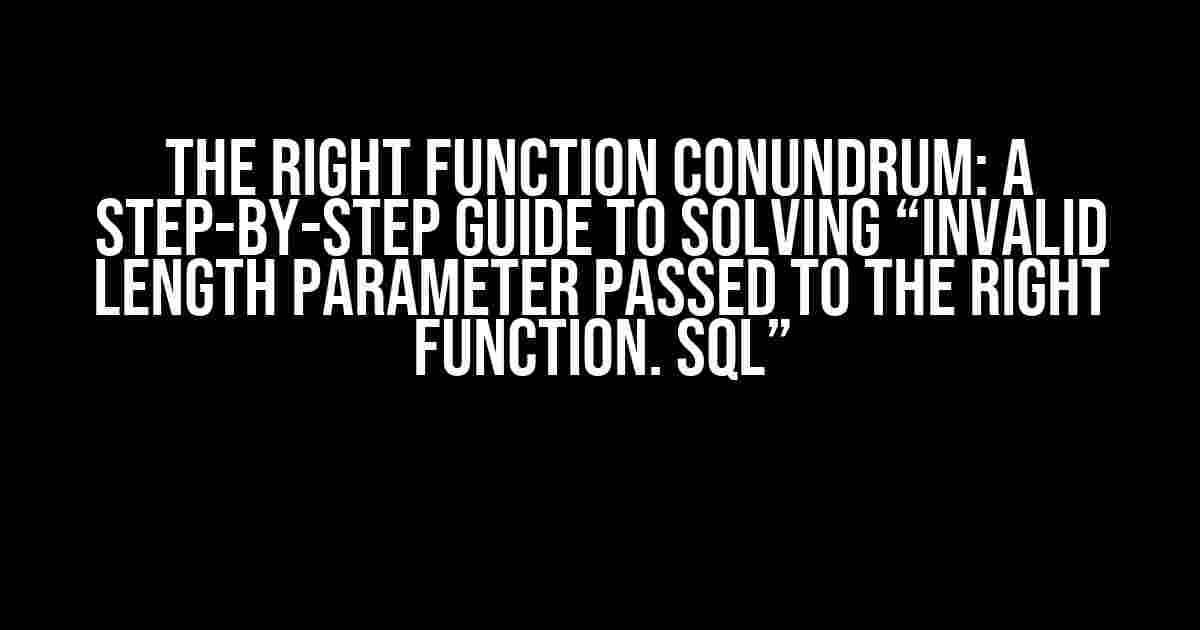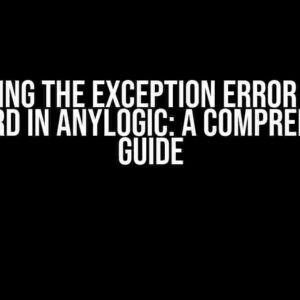Are you stuck in a SQL nightmare, haunted by the cryptic error message “Invalid length parameter passed to the RIGHT function. SQL”? Fear not, dear developer, for we’re about to embark on a thrilling adventure to vanquish this pesky problem once and for all!
The Scene of the Crime: Understanding the RIGHT Function
The RIGHT function, a stalwart of the SQL world, is designed to extract a specified number of characters from the right side of a string. Sounds simple, right? Yet, it’s deceptively complex, and that’s where our tale begins.
RIGHT(string, length)
In the above syntax, `string` is the input string, and `length` is the number of characters to be extracted from the right side. But what happens when this `length` parameter goes awry?
The Error: “Invalid length parameter passed to the RIGHT function. SQL”
This error crops up when the `length` parameter is either:
NULL, forcing the RIGHT function to throw its hands up in despair.- A negative value, which makes no sense in the context of extracting characters from the right side of a string.
- A non-numeric value, such as a string or a datetime, causing the function to malfunction.
In each of these scenarios, the RIGHT function is unable to interpret the `length` parameter, resulting in the “Invalid length parameter passed to the RIGHT function. SQL” error.
The Investigation: Identifying the Culprit
To solve this enigma, we need to scrutinize our SQL code, following the trail of clues to uncover the source of the error.
- Review the SQL query: Take a close look at the RIGHT function’s syntax and arguments. Ensure that the `length` parameter is correctly defined and not being passed a
NULLor invalid value. - Check for variables: If you’re using variables to pass values to the RIGHT function, verify that they’re properly declared and initialized.
- Inspect data types: Confirm that the `length` parameter is of a numeric data type (e.g.,
INT,BIGINT, orDECIMAL). Avoid using strings or datetime values, which can lead to type mismatches.
The Solution: Fixing the “Invalid length parameter passed to the RIGHT function. SQL” Error
Now that we’ve identified the root cause of the error, it’s time to apply the fixes:
-- Original code with error
SELECT RIGHT('hello', NULL) AS result;
-- Fixed code
DECLARE @length INT = 3;
SELECT RIGHT('hello', @length) AS result;
In the corrected code, we’ve:
- Declared a variable
@lengthof typeINT. - Initialized the variable with a valid numeric value (
3). - Passed the variable to the RIGHT function, ensuring a valid `length` parameter.
Additional Tips and Tricks
To avoid encountering this error in the future, keep the following best practices in mind:
| Tip | Description |
|---|---|
| Use ISNULL or COALESCE | Wrap the `length` parameter with ISNULL or COALESCE to return a default value (e.g., 0) when NULL is encountered. |
| Cast or convert data types | Explicitly cast or convert non-numeric values to a compatible numeric data type (e.g., CAST(@length AS INT)). |
| Validate user input | Verify user-provided input values to ensure they’re numeric and within a reasonable range. |
The Verdict: Solving the Mystery of the “Invalid length parameter passed to the RIGHT function. SQL” Error
By applying the steps outlined in this article, you should be able to resolve the “Invalid length parameter passed to the RIGHT function. SQL” error and get your SQL queries running smoothly. Remember to stay vigilant, as this error can creep up unexpectedly. With practice and patience, you’ll become a master detective, adept at solving even the most obscure SQL mysteries!
Now, go forth and conquer the world of SQL, armed with the knowledge and skills to tackle the “Invalid length parameter passed to the RIGHT function. SQL” error head-on!
Here are 5 Questions and Answers about “Invalid length parameter passed to the RIGHT function. SQL” in a creative voice and tone:
Frequently Asked Question
Stuck with SQL errors? Don’t worry, we’ve got your back! Here are some answers to your burning questions about “Invalid length parameter passed to the RIGHT function. SQL”.
What does “Invalid length parameter passed to the RIGHT function” mean?
This error message is telling you that the length parameter you’re passing to the RIGHT function is invalid. The RIGHT function in SQL is used to extract a specified number of characters from the right side of a string. If the length parameter is negative, zero, or not an integer, you’ll get this error. Make sure to check your syntax and ensure that the length parameter is a positive integer!
Why does the RIGHT function require a positive integer length parameter?
The RIGHT function needs a positive integer length parameter because it’s designed to extract a specific number of characters from the right side of a string. If you pass a negative number or zero, the function wouldn’t know how many characters to extract, resulting in an error. By requiring a positive integer, the function can accurately extract the desired number of characters.
How do I fix the “Invalid length parameter passed to the RIGHT function” error?
To fix this error, simply ensure that the length parameter you’re passing to the RIGHT function is a positive integer. Check your syntax, and make sure you’re not passing any negative numbers, zero, or non-integer values. If you’re using a variable to pass the length parameter, verify that it’s set to a positive integer value.
Can I use the RIGHT function with other data types, like integers or dates?
No, the RIGHT function is specifically designed to work with string data types, like VARCHAR, CHAR, or TEXT. If you try to use it with other data types, like integers or dates, you’ll get a syntax error or an incorrect result. Make sure to only use the RIGHT function with string columns or expressions.
Are there any alternatives to the RIGHT function in SQL?
Yes, there are alternatives to the RIGHT function, depending on the specific database management system you’re using. For example, in some databases, you can use the SUBSTRING function with a negative starting position to achieve similar results. Additionally, some databases support regular expressions, which can be used to extract patterns from strings. However, the RIGHT function is a widely supported and efficient way to extract characters from the right side of a string.



